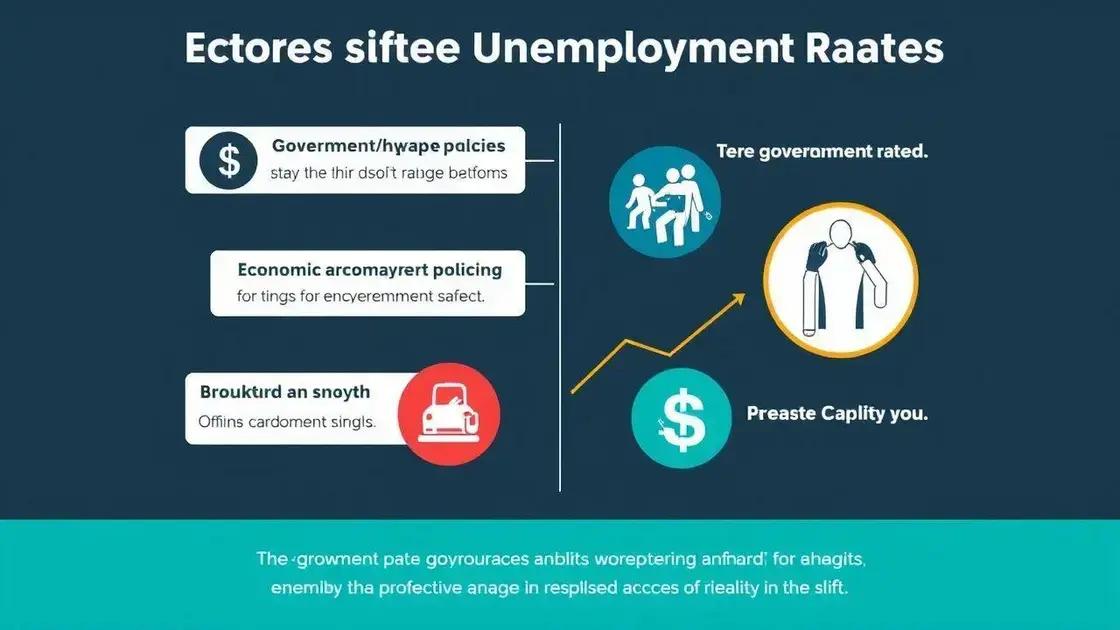Unemployment rate hits new low, signaling economic recovery

The low unemployment rate signifies a positive economic trend, offering more job opportunities, enhanced job security, and potential increases in wages for workers.
Unemployment rate hits new low, and this trend might just signal a turning point for the economy. Have you considered how such changes could affect your job prospects or financial security? Let’s dive into what this really entails.
Understanding the current unemployment trends
Understanding the current unemployment trends is crucial for grasping the economic landscape. As we analyze these trends, we can gain valuable insights into how they impact job availability and economic growth.
Overview of Recent Data
Recent statistics show a significant decline in the unemployment rate. Many experts believe that this is a sign of a robust economic recovery. However, it is essential to look deeper into the factors that contribute to these changes.
Key factors influencing unemployment
- Economic policies promoting job creation
- Improvements in various sectors such as technology and healthcare
- Workforce development programs
- Increased consumer demand driving business growth
These factors demonstrate that the decreased unemployment rate is not just a number but a reflection of positive developments in the economy. As more jobs become available, individuals are better positioned to enter the workforce.
Additionally, the unemployment trends indicate shifts in the types of jobs that are in demand, especially in evolving industries. Understanding these shifts helps job seekers focus their efforts on skills that are more sought after in today’s market.
Industry impact
Different industries experience varying effects from the changes in the unemployment rate. For example, technology-related jobs have surged, while traditional roles may experience stagnation. This is an essential factor for those contemplating a career change or entry into the workforce.
Key factors behind the low unemployment rate

Many factors contribute to the low unemployment rate. Understanding these key elements helps clarify why more people are finding jobs and how the economy is improving.
Government Policies
Supportive government policies play a crucial role in reducing unemployment. By creating initiatives that encourage job growth, businesses can expand and hire more employees.
- Tax incentives for companies hiring new staff
- Investment in infrastructure projects
- Funding for job training programs
These policies ensure that job opportunities arise in various sectors, which helps to keep the unemployment rate low.
Economic Growth
Strong economic growth is often linked to low unemployment. When the economy is booming, businesses tend to hire more individuals to meet increasing demand. This is evident in industries like technology and healthcare, where rapid growth leads to more job openings.
Additionally, as consumer confidence increases, spending rises, further stimulating economic activity. This creates a cycle where low unemployment is both a result and a catalyst for continued growth.
Shifts in Workforce Needs
The job market is constantly evolving, with new skills and roles emerging. As businesses adapt to technology and market needs, they look for workers who possess the right skill sets. This demand can lead to a temporary decrease in unemployment as companies seek to fill these roles.
Moreover, training and education programs specifically designed to equip workers with the necessary skills are essential. These programs help ensure that the labor force remains competitive and aligned with industry trends.
Impact on different economic sectors
The low unemployment rate has a diverse impact on various economic sectors. Understanding these effects helps us see the bigger picture of economic stability and growth.
Positive Effects on Key Industries
Several industries experience a boost from a low unemployment rate. This includes technology, healthcare, and manufacturing, where demand for skilled workers is high. As more jobs become available, these sectors can grow and expand.
- Technology Sector: Rapid advancements require more engineers and software developers.
- Healthcare Sector: An aging population increases the need for healthcare professionals.
- Manufacturing Sector: Increased production often leads to the hiring of more workers.
In these areas, a healthy job market allows businesses to innovate and compete effectively.
Challenges for Other Sectors
On the other hand, some sectors face challenges due to a low unemployment rate. These sectors might struggle to find qualified candidates, leading to slower growth. The service industry, for example, sometimes finds it hard to attract workers due to lower wages.
When the job market is tight, employers may need to offer better wages and benefits. This can increase operational costs, which might affect pricing and profitability.
Long-term Economic Growth
Despite challenges, a low unemployment rate generally points to a thriving economy. It encourages consumer spending as more people have jobs and income. This spending then fuels business growth across sectors. A low unemployment rate creates a stable environment that can lead to long-term economic prosperity.
What this means for the average worker

The low unemployment rate has significant implications for the average worker. With more jobs available, individuals have greater opportunities to find positions that match their skills and needs.
Increased Job Opportunities
For many, a low unemployment rate means a wider array of job options. Workers can explore roles that they might not have considered before. This abundance allows them to choose positions that offer better pay or more desirable working conditions.
- Greater flexibility in job selection
- More potential for career advancement
- Opportunities to negotiate better salaries
As competition for workers rises, employers are often willing to improve wages and benefits to attract talent.
Job Security and Confidence
A low unemployment rate can also boost job security for current employees. Knowing that many positions are available can reduce fear of layoffs. When workers feel secure, they are more likely to invest in their careers through training and continuing education.
Confidence in the job market ensures that workers are more engaged and motivated. This positivity can lead to increased productivity, benefiting both employees and employers.
Challenges Faced
However, there are challenges that come with a low unemployment rate. For instance, as more workers enter the job market, some industries may struggle to find qualified candidates. This can lead to a mismatch between available jobs and the skills of job seekers.
Additionally, if wages do not keep pace with inflation, the benefits of lower unemployment might diminish for workers. It’s essential for employees to stay informed and adapt to these changes to maximize their opportunities.
FAQ – Frequently Asked Questions about Low Unemployment Rate
What does a low unemployment rate mean for workers?
A low unemployment rate indicates more job opportunities, greater job security, and often higher wages for workers.
How does the unemployment rate affect economic growth?
A low unemployment rate is generally a sign of economic growth, as more people are employed and contributing to consumer spending.
What challenges do industries face with low unemployment?
Industries may struggle to find qualified candidates, leading to skill mismatches and potential slowdowns in growth.
Why is adaptability important for workers in a changing job market?
Adaptability allows workers to stay informed on trends and skills that are in demand, helping them seize job opportunities.





